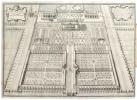Istoria e coltura delle piante che sono pe'l fiore più ragguardevoli , e più distinte per ornare un giardino... con un copioso trattato degli agrumi...
Eur 5,000 / USD 5,500
The price shown on each item does not include V.A.T (Value Added Tax). As a result of the recent EU legislation we are required to charge our EU customers the percentage of V.A.T. charged by the customer’s country of residence, unless they possess a V.A.T. registration number. Postage Additional.
Venezia, presso Andrea Poletti, 1726. 4to (235 x 175mm). pp. (34), 761, (3), with an engraved portrait of Clarici holding a bouquet of flowers in his right hand, an engraved title-vignette with a dwarf lemon tree in a pot with two putti, and a large engraved plan (530 x 740mm) of the Villa Marocco and its gardens. Contemporary half vellum, spine with red gilt lettered label, marbled sides.
one of the most important works on flower gardens and the cultivation of flowers of Northern Italy
A fine copy of the first and only edition of one of the most important works on flower gardens and the cultivation of flowers of Northern Italy. Paolo Bartolomeo Clarici (1664-1725) 'spent most of his life in the Veneto where his literary and scientific tastes brought him the friendship of many members of the great Venetian families. Prominent among these was Gerardo Sagredo, Procurator of St Mark's, for whom he laid out a splendid garden in the Venetian style for the family villa at Marocco... Clarici used a print of a bird's eye view of this Marocco garden in his book as an ideal example of layout... predominantly a flower garden' (Masson, Italian gardens).
'The work is divided into four sections: the first provides the reader with a brief history of the garden architecture and instructions on how to contruct a proper garden; the second is dedicated to cultivation techniques; the third to botanical history and the cultivation of certain prized flowering plants; and the fourth to a dissertation on citrus plants... 'Istoria e coltura della piante' was a work of serious scholarship, one based on careful reading of the most recent scientific works on botanical subjects as well as the author's own research. Thus Clarici left behind him a useful legacy that was to influence generations of garden architects and floriculturists both in Italy and elsewhere' (Tomasi, An Oak Spring Flora pp. 140-2).
Pritzel 1728; Tomasi, An Oak Spring Flora No. 36.




